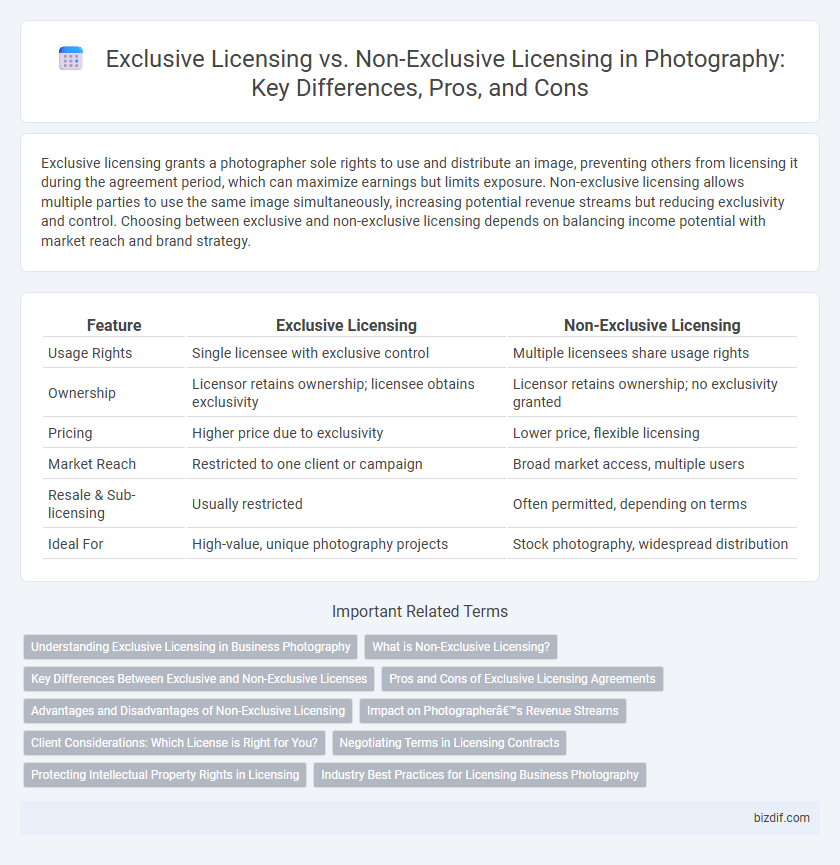Exclusive licensing grants a photographer sole rights to use and distribute an image, preventing others from licensing it during the agreement period, which can maximize earnings but limits exposure. Non-exclusive licensing allows multiple parties to use the same image simultaneously, increasing potential revenue streams but reducing exclusivity and control. Choosing between exclusive and non-exclusive licensing depends on balancing income potential with market reach and brand strategy.
Table of Comparison
| Feature | Exclusive Licensing | Non-Exclusive Licensing |
|---|---|---|
| Usage Rights | Single licensee with exclusive control | Multiple licensees share usage rights |
| Ownership | Licensor retains ownership; licensee obtains exclusivity | Licensor retains ownership; no exclusivity granted |
| Pricing | Higher price due to exclusivity | Lower price, flexible licensing |
| Market Reach | Restricted to one client or campaign | Broad market access, multiple users |
| Resale & Sub-licensing | Usually restricted | Often permitted, depending on terms |
| Ideal For | High-value, unique photography projects | Stock photography, widespread distribution |
Understanding Exclusive Licensing in Business Photography
Exclusive licensing in business photography grants a single client the sole right to use the images, preventing the photographer from licensing the photos to other parties. This arrangement often commands higher fees due to the restricted usage and increased value for the client's brand exclusivity. Understanding the legal terms and duration of the license is crucial to ensure rights are clearly defined and protected for both photographer and client.
What is Non-Exclusive Licensing?
Non-exclusive licensing allows photographers to grant usage rights of their images to multiple clients simultaneously, maximizing exposure and revenue opportunities. This type of license does not transfer ownership, enabling the photographer to retain full control while licensing the same photo to various parties. Non-exclusive agreements typically include specific terms outlining how and where the images can be used, ensuring clear usage rights for both the photographer and licensees.
Key Differences Between Exclusive and Non-Exclusive Licenses
Exclusive licensing grants the licensee sole rights to use and distribute the photograph, preventing the photographer or others from licensing the same image to anyone else during the license term. Non-exclusive licensing allows the photographer to sell the same image to multiple licensees, enabling broader distribution but less control for each buyer. The choice between exclusive and non-exclusive licenses hinges on factors such as usage restrictions, pricing, and the intended scope of commercial exploitation.
Pros and Cons of Exclusive Licensing Agreements
Exclusive licensing grants photographers full control over image use, allowing higher pricing and reduced competition, which maximizes revenue potential. However, this exclusivity limits exposure since the image can only be used by one licensee, potentially reducing overall market reach. Photographers must weigh guaranteed income and brand prestige against restricted distribution and the risk of client dependency.
Advantages and Disadvantages of Non-Exclusive Licensing
Non-exclusive licensing allows photographers to retain ownership of their images while granting usage rights to multiple clients, increasing potential revenue streams and exposure. This licensing type offers flexibility and broad distribution but may reduce the perceived uniqueness of the work and limit control over how and where images are used. Photographers must balance wider market reach against the risk of oversaturation and potential conflicts with clients seeking exclusivity.
Impact on Photographer’s Revenue Streams
Exclusive licensing grants a photographer sole rights to a specific image, often resulting in higher upfront fees and limited distribution that can increase the image's value and exclusivity. Non-exclusive licensing allows multiple users to license the same image simultaneously, generating continuous but typically lower revenue per license. Balancing exclusive and non-exclusive agreements diversifies income streams and maximizes long-term earnings from a photographer's portfolio.
Client Considerations: Which License is Right for You?
When deciding between exclusive and non-exclusive photography licensing, clients should consider their intended usage and budget constraints. Exclusive licenses grant sole rights, ensuring no other party uses the image, ideal for brands seeking unique visual identity. Non-exclusive licenses offer more affordable flexibility, allowing multiple clients to use the same image without exclusivity.
Negotiating Terms in Licensing Contracts
Negotiating terms in photography licensing contracts requires careful consideration of exclusive versus non-exclusive agreements, impacting usage rights and revenue streams. Exclusive licenses grant sole usage rights to one licensee, often commanding higher fees and stricter limitations on the photographer's ability to license the same images to others. Non-exclusive licenses allow multiple users, necessitating clear negotiation on usage scope, duration, and geographical restrictions to maximize exposure while preserving ongoing income potential.
Protecting Intellectual Property Rights in Licensing
Exclusive licensing grants photographers sole rights to use or distribute an image, preventing others from exploiting the work and ensuring stronger protection of intellectual property. Non-exclusive licensing allows multiple parties to use the same photograph, which can limit control but increase revenue opportunities. Understanding these distinctions is crucial for photographers aiming to safeguard their creative assets while maximizing licensing benefits.
Industry Best Practices for Licensing Business Photography
Exclusive licensing in commercial photography grants a single client the sole right to use images, ensuring controlled distribution and higher revenue potential, often preferred for high-stakes branding campaigns. Non-exclusive licensing allows photographers to license the same images to multiple clients, maximizing exposure and diversified income streams while requiring meticulous contract clarity to avoid misuse. Industry best practices recommend clear terms on usage limits, duration, and territory in both licensing types to protect photographers' intellectual property and maintain professional relationships.
Exclusive Licensing vs Non-Exclusive Licensing Infographic

 bizdif.com
bizdif.com